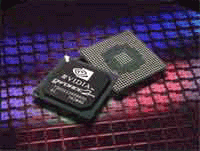NVIDIA GeForce 2 GTS Roundup - July 2000
by Matthew Witheiler on July 10, 2000 4:39 AM EST- Posted in
- GPUs
The GPU
 The
GeForce 2 GTS is more than just a .18 micron version of its GeForce 256 brother.
On top of this major advantage, which allowed for NVIDIA to push the speed of
the GeForce 2 GTS to 200 MHz, speeds that the GeForce 256 could never achieve,
NVIDIA also added many features to the core.
The
GeForce 2 GTS is more than just a .18 micron version of its GeForce 256 brother.
On top of this major advantage, which allowed for NVIDIA to push the speed of
the GeForce 2 GTS to 200 MHz, speeds that the GeForce 256 could never achieve,
NVIDIA also added many features to the core.
First off, NVIDIA made the GeForce 2 GTS able to process two textures per each one of its four pipelines during each clock. This improved the maximum fill rate of the processor from the one texture GeForce 256, raising the fill rate to 1.6 gigatextels. The memory clock speed of the GeForce 2 GTS has been increased to 166 MHz DDR (333 MHz effective) to help cope with this added speed. In addition, the GeForce 2 GTS incorporates NVIDIA's Shading Rasterizer (NSR). This feature allows the GeForce 2 GTS to perform a large number of pixel shading effects in hardware, for a total of 7 pixel operations to be performed in a single pass. These operations include shadow maps, bump mapping (EMBM, Dot Product 3, and embossed), shadow volumes, volumetric explosion, elevation maps, vertex blending, waves, refraction and specular lighting all on a per-pixel basis. These features of the GPU, along with the increased core speed, all make for a processor that is significantly faster than its older brother. However, NVIDIA did not stop there.
On top of the speed increases gained by the GeForce 2 GTS, there are also additional features that are included in the GPU that make it even more powerful. For one, the T&L engine has been upgraded to allow for processing of all transformation, clipping and lighting calculations on the chip itself. Although we are yet to see these features in action in the real world, they do provide increased longevity. In addition, the GPU of the GeForce 2 GTS has a built-in TMDS, allowing for cheap DVI functions. Previously, the TMDS was located off chip and had to be purchased separately by a manufacturer to add DVI support. By including the TMDS on chip, NVIDIA has paved the way for cheap and easy DVI output. Finally, the GeForce 2 GTS features an integrated High Definition Video Processor (HDVP) which supports all ATSC formats. For more information on the GeForce 2 GTS, check out our review of it here.
All of these features combine to produce one of the most powerful graphics chips on the market. However, it is always possible to improve upon a good thing. To do this with the GeForce 2 GTS requires an extra bit of tweaking: overclocking.










0 Comments
View All Comments